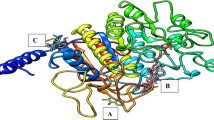The liver performs detoxification, making it vulnerable to damage by common hepatotoxic medicines such as acetaminophen. Finding new medicines to prevent and treat liver damage caused by hepatotoxic drugs is an important area of research. In this study, an Iranian endemic plant Scrophularia striata that belongs to the botanical family containing hepatoprotective compounds was selected for phytochemical, biochemical and histopathological studies against acetaminophen hepatotoxicity in mice. Animals were treated for 6 days with methanolic extract (100, 300, 1000 mg/kg) and then received an acetaminophen toxic dose (400 mg/kg) on the last day. Blood and liver tissue samples were prepared 24 hours later. HPTLC chromatograms showed different phytochemicals including phenolics and triterpenoids. The plant extract decreased the activity of liver enzymes and liver tissue injuries significantly. Our results showed a hepatoprotective effect of S. striata against acetaminophen-induced hepatotoxicity and indicated that these effects can be due to the presence of phenolic and triterpenoid content.






Similar content being viewed by others
References
A. Ramachandran and H. Jaeschke, Antioxid. Redox Signaling, 35(9), 718 – 733 (2021).
A. L. Chiew and N. A. Buckley, Crit. Care Clin., 37(3), 543 – 561 (2021).
A. Ramachandran and H. Jaeschke, Gene Expression, 18(1), 19 – 30 (2018).
G. B. Xu, Y. H. Xiao, Q. Y. Zhang, et al., Eur. J. Med. Chem., 145, 691 – 716 (2018).
P. Saha, A. D. Talukdar, R. Nath, et al., Front. Pharmacol., 10, 509 (2019).
C. Wang, X. Gong, A. Bo, et al., Molecules, 25(2) (2020).
V. Mozaffarian, A Dictionary of Iranian Plant Names Latin-English-Persian, Faehang Moaser, Tehran (2013), p. 497.
N. Tanideh, M. H. Haddadi, M. H. Rokni-Hosseini, et al., World J. Plast. Surg., 4(1), 16 – 23 (2015).
S. S. Mousavi, A. Karami, T. M. Haghighi, et al., Plants, 10(1) (2021).
A. Amin, E. Tuenter, K. Foubert, et al., Front. Pharmacol., 8, 232 (2017).
E. Reich and A. Schibli, High-performance thin-layer chromatography for the analysis of medicinal plants, Thieme (2007).
H. Nikravesh, M. J. Khodayar, M. Mahdavinia, et al., Adv. Pharm. Bull., 8(2), 331 – 339 (2018).
S. Agatonovic-Kustrin, E. Kustrin, V. Gegechkori, and D. W. Morton, Mar. Drugs, 17(3), 148 (2019).
W. Oleszek, I. Kapusta and A. Stochmal, TLC of Triterpenes (Including Saponins), in: Thin Layer Chromatography in Phytochemistry, M. Waksmundzka-Hajnos, J. Sherma and T. Kowalska (eds), CRC Press, (2008), pp. 519 – 541.
F. H. Kasten, The origins of modern fluorescence microscopy and fluorescent probes, in: Cell structure and function by microspectrofluorometry, E. Kohen (ed.), Academic Press, (1989), pp. 3 – 50.
S. Baby, A. J. Johnson, B. Govindan, et al., Sci. Rep., 3(1), 1 – 6 (2013).
M. Medic-Saric, I. Jasprica, A. Mornar, and Z. Males, Application of TLC in the isolation and analysis of flavonoids, in: Chromatographic Science Series, 99, 405 (2008).
K. Karthika and S. Paulsamy, Indian J. Pharm. Sci., 77(1), 111 – 116 (2015).
A. Pasdaran and A. Hamedi, Pharm. Biol. (Abingdon, U. K.), 55(1), 2211 – 2233 (2017).
H. R. Monsef-Esfahani, R. Hajiaghaee, A. R. Shahverdi, et al., Pharm. Biol. (Abingdon, U. K.), 48(3), 333 – 336 (2010).
P. Wexler, Encyclopedia of toxicology, Elsevier / Academic Press (2014).
S. Schramm, N. Köhler and W. Rozhon, Molecules, 24(3), 498 (2019).
P. Mazraati and M. Minaiyan, Adv. Biomed. Res., 7, 67 (2018).
M. Abdel-Daim, A. I. Abushouk, R. Reggi, et al., J. Food Drug Anal., 26(2s), S78-S87 (2018).
A. Hanafy, H. M. Aldawsari, J. M. Badr, et al., J. Evidence- Based Complementary Altern. Med., 2016, 4579149 (2016).
M. T. Olaleye, A. C. Akinmoladun, A. A. Ogunboye, and A. A. Akindahunsi, Food Chem. Toxicol., 48(8 – 9), 2200 – 2205 (2010).
H. Shayani-Jam and D. Nematollahi, Chem. Commun. (Cambridge, U.K.), 46(3), 409 – 411 (2010).
G. F. Rushworth and I. L. Megson, Pharmacol. Ther., 141(2), 150 – 159 (2014).
S. Singh, L. S. Hynan and W. M. Lee, Dig. Dis. Sci., 58(5), 1397 – 1402 (2013).
O. Sabzevari, A. Hosseini, H. Paydar, and H. R. Monsef-Esfahani, Toxicol. Lett., 180, S57 (2008).
H. S. Garg, S. P. S. Bhandari, S. C. Tripathi, et al., Phytother. Res., 8(4), 224 – 228 (1994).
H. M. Kim, M. J. Ahn and S. Lee, J. Med. Plants Res., 6(22), 3923 – 3930 (2012).
A. Venditti, C. Frezza, M. Riccardelli, et al., Nat. Prod. Res., 30(14), 1665 – 1669 (2016).
H. Y. Kim, J. Park, K. H. Lee, et al., Toxicology, 282(3), 104 – 111 (2011).
E. Fernández-Martínez, R. A. Bobadilla, M. S. Morales-Ríos, et al., Med. Chem., 3(5), 475 – 9 (2007).
E. J. Lee, S. R. Kim, J. Kim, and Y. C. Kim, Planta Med., 68(5), 407 – 411 (2002).
L. Aguirre, M. P. Portillo, E. Hijona, and L. Bujanda, World J. Gastroenterol., 20(23), 7366 – 7380 (2014).
Author information
Authors and Affiliations
Corresponding author
Rights and permissions
Springer Nature or its licensor (e.g. a society or other partner) holds exclusive rights to this article under a publishing agreement with the author(s) or other rightsholder(s); author self-archiving of the accepted manuscript version of this article is solely governed by the terms of such publishing agreement and applicable law.
About this article
Cite this article
Bavandipour, A., Jangravi, Z., Kondori, B.J. et al. High-Performance Thin-Layer Chromatography Fingerprinting Analysis and Hepatoprotective Effects of Scrophularia striata Aerial Parts Against Acetaminophen-Induced Acute Hepatotoxicity in Mice. Pharm Chem J 57, 1476–1485 (2023). https://doi.org/10.1007/s11094-023-03013-w
Received:
Published:
Issue Date:
DOI: https://doi.org/10.1007/s11094-023-03013-w




